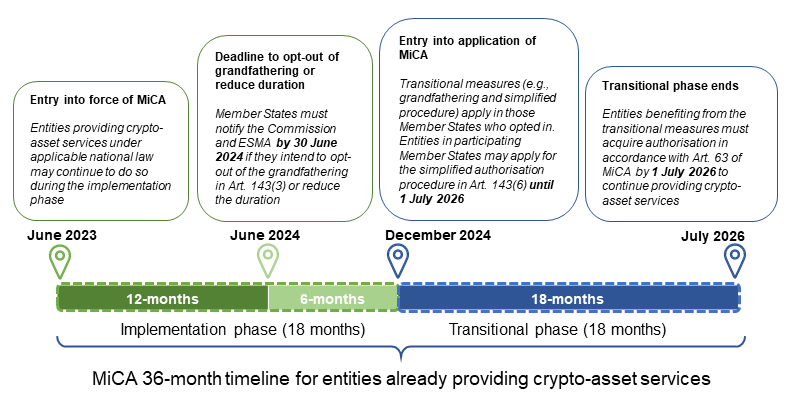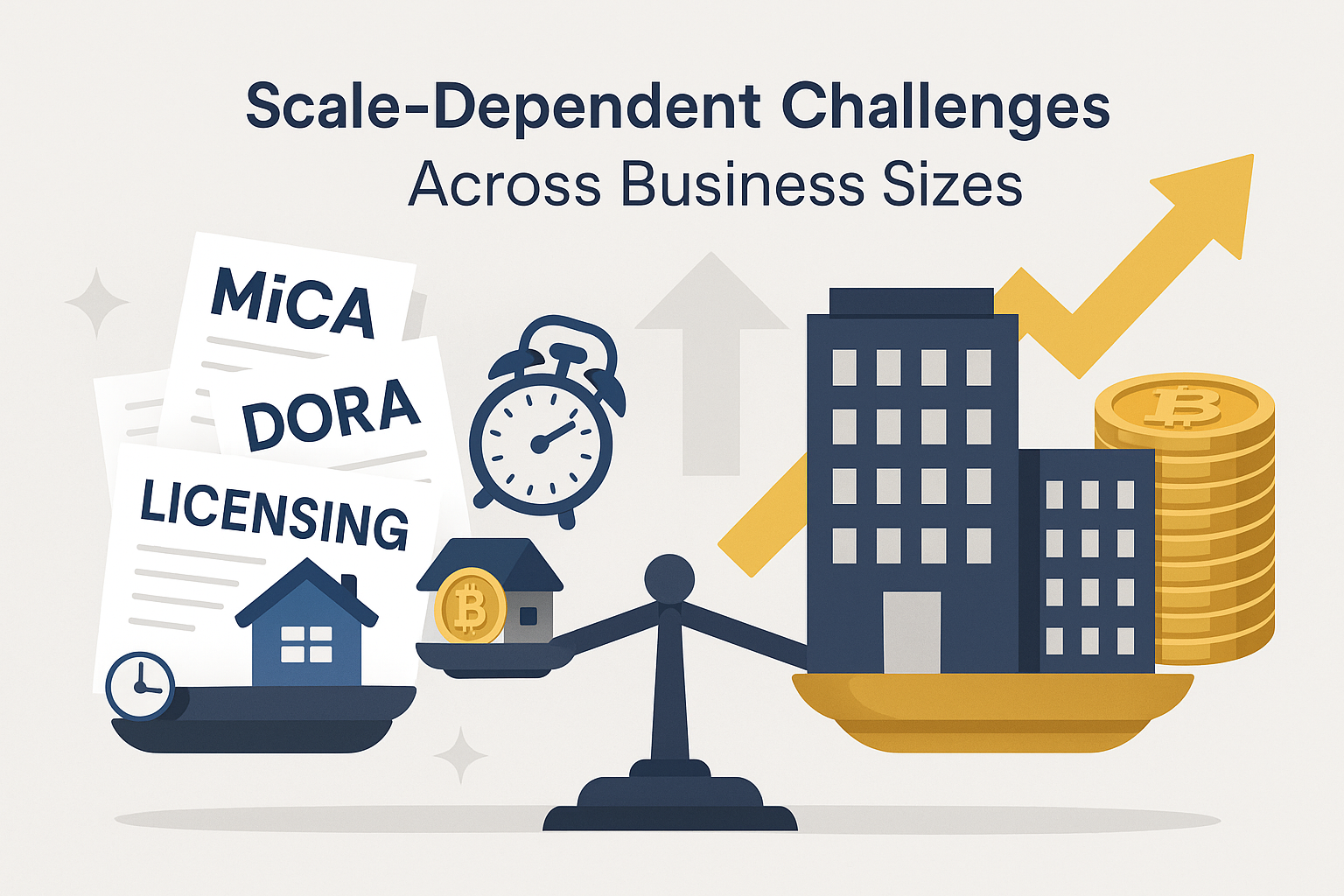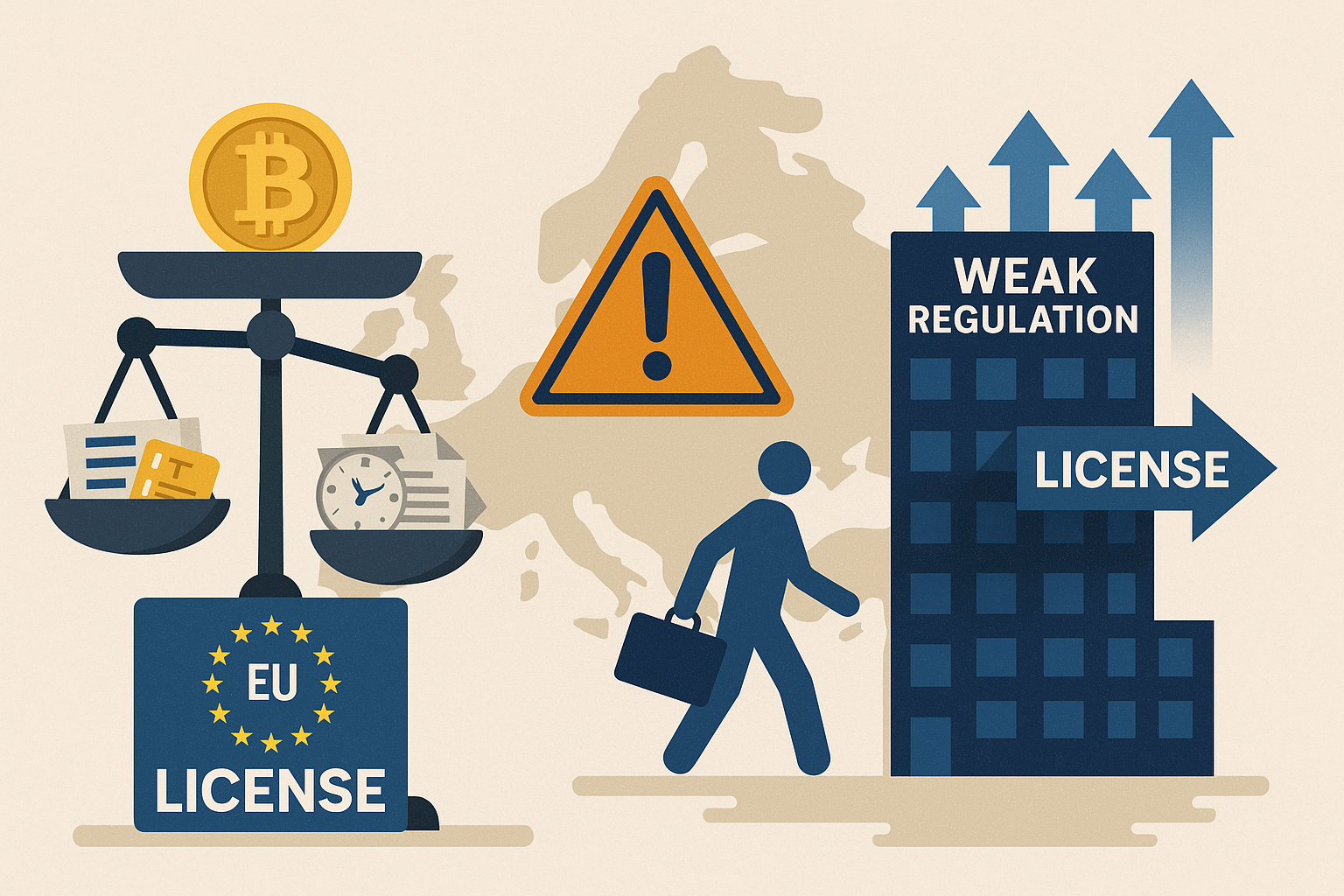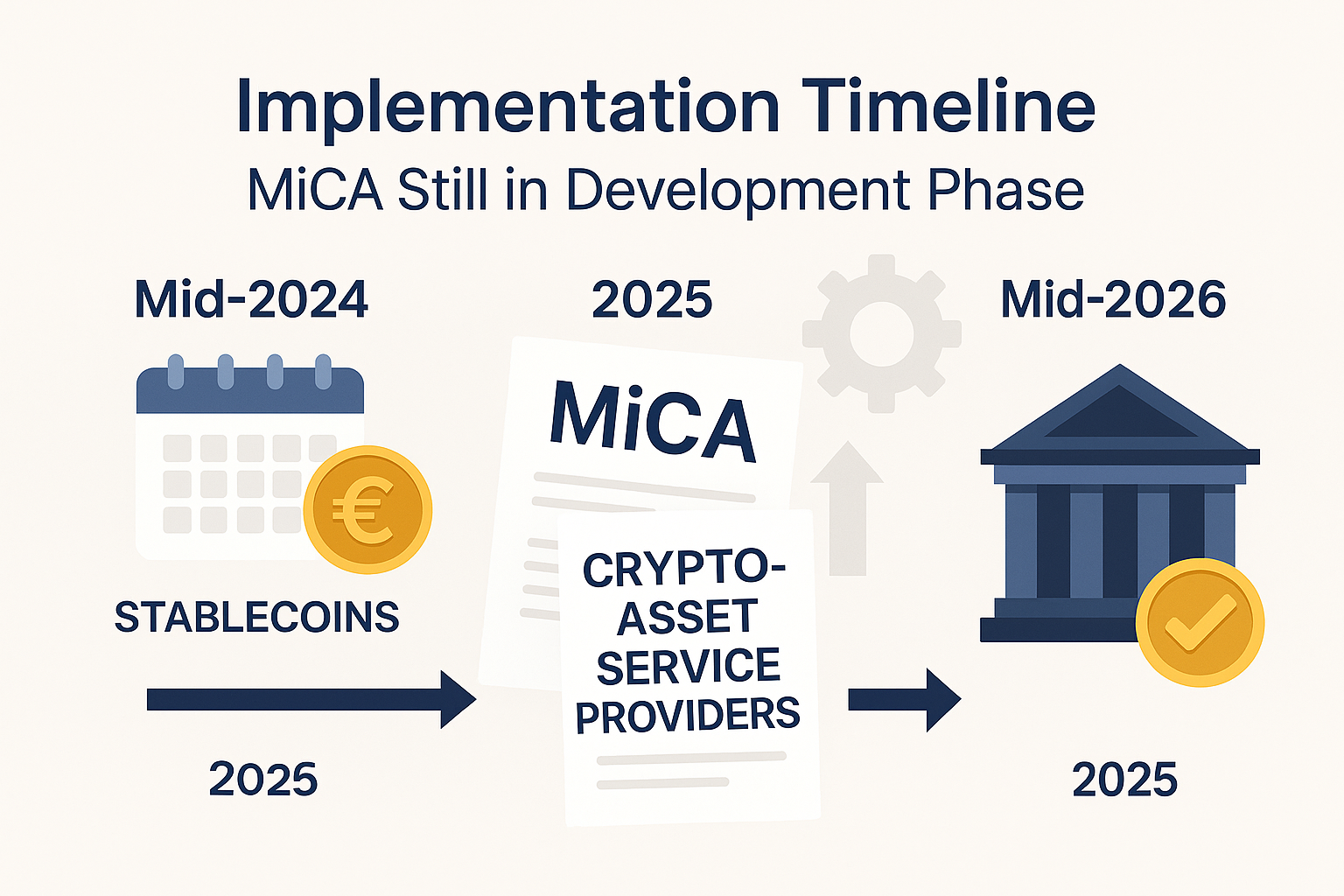MiCA Passporting Challenges: Europe’s Unified Crypto Market
MiCA passporting is at the center of Europe’s push to build a unified regulatory framework for digital assets. Designed to replace a patchwork of 27 national regimes with one coherent rulebook, MiCA gives companies a single license to operate across the bloc. The passporting system aims to cut compliance costs, speed up expansion, and position the EU as a global leader in crypto regulation.
Yet the first year of implementation has already revealed cracks. Regulators in France, Italy, and Austria warn that passporting could encourage “license shopping,” allowing firms to base themselves in the most lenient jurisdictions and still access the entire market. Diverging supervisory practices across member states risk undermining the very unity MiCA was meant to deliver. This article explores the challenges surrounding passporting and what they mean for Europe’s ambition to set the global standard in crypto oversight.
Background and Significance of the MiCA Regulatory Framework
The Markets in Crypto-Assets Regulation (MiCA) represents the European Union’s most ambitious step toward building a single rulebook for digital assets. After years of negotiation, MiCA entered into force in 2023, with its provisions taking effect in two waves: rules for stablecoins became binding in mid-2024, while the broader framework for crypto-asset service providers and token issuers followed in late 2024. Transitional measures extend until mid-2026, giving firms already licensed under national regimes limited time to align with the new EU standard.

Before MiCA, Europe’s crypto industry was defined by fragmentation. Each of the 27 member states operated its own licensing system, producing regulatory overlap, gaps in investor protection, and high barriers to cross-border expansion. This patchwork structure not only discouraged startups from scaling but also weakened Europe’s ability to compete with markets like the United States and Asia, where firms could often access larger pools of capital and users more efficiently. MiCA was designed to replace this inefficiency with a harmonised framework covering asset issuance, service provision, and trading activity, while embedding strict obligations on consumer protection, anti-money laundering, operational resilience, and market transparency.
The Passporting Mechanism: Central to European Unification Ambitions
Passporting is the linchpin of MiCA’s promise to create a single European crypto market. This system allows companies licensed to operate crypto activities in one EU member state to automatically extend their services to all other 26 countries without needing to undergo separate licensing processes in each jurisdiction.

This mechanism is modeled after other successful frameworks within the European financial system, particularly in banking and securities. In the banking sector, the passporting system has allowed banks licensed in one EU country to operate freely throughout the union, creating an integrated and competitive financial market.
For the crypto industry, the benefits of the passporting system are clear. Startups and established companies can significantly reduce compliance costs, shorten time-to-market, and immediately access a potential market of over 400 million consumers. This is particularly important in an industry characterized by rapid innovation and fierce global competition.
However, the success of the passporting system depends entirely on all member states implementing and enforcing MiCA consistently. If national regulators interpret or apply rules differently, then the entire principle of a unified market will be undermined, and companies will continue to face regulatory uncertainty and fragmentation.
First Disagreements: Concerns from France, Italy, and Austria
Less than a year into MiCA’s application, unity has started to fray. France, Italy, and Austria have challenged the way passporting operates, warning that it could open the door to regulatory arbitrage. Their concern is simple: a firm that secures approval in a lenient jurisdiction could immediately use that licence to access the entire EU market, even if the level of scrutiny falls short of MiCA’s intent.
France’s AMF has been the most vocal critic, drawing parallels with the MiFID era. Back then, retail trading platforms flocked to jurisdictions like Cyprus and Malta, where requirements were lighter and approvals faster. Regulators fear a repeat in crypto, especially in smaller states with limited supervisory capacity and little experience overseeing complex digital-asset businesses.
To address this, France and its allies have called for stronger centralisation. They argue that ESMA should take direct responsibility for supervising the largest, most cross-border providers, echoing the model used for major banks under the European Banking Union. Supporters believe this shift would close loopholes, restore confidence in the passporting regime, and ensure that a MiCA licence carries the same weight across all 27 member states.
Expert Analysis from Industry: Coinshares’ Perspective
For regulators, MiCA is a test of consistency. For businesses, it is a question of certainty. Few voices capture this tension better than Jerome Castile, Head of Compliance and Regulatory Affairs for Europe at Coinshares, who has seen these dynamics play out across Europe’s financial markets.
“Regulatory competition in Europe is not new,” Castile explains. “We’ve seen this phenomenon in many other areas of financial markets. Under MiFID rules governing brokers and trading platforms, we’ve witnessed retail trading platforms flocking to Cyprus and Malta. Similarly, in the world of payment institutions, some Eastern jurisdictions have captured significant market share.”
MiCA was supposed to change that. France, deeply involved in shaping the regulation, expected its influence to deliver a consistent framework. Instead, uneven enforcement is already emerging as a risk.
The difference now is clarity. “What makes the issue clearer is that regulators now have clear visibility into what’s happening with these crypto asset service providers,” Castile notes. “Many issues they’ve created for themselves, or at least been accepted by other regulators elsewhere.”
Real Business Impact: Coinshares’ Experience
Coinshares itself illustrates both the promise and the friction of MiCA. In July 2024, France’s AMF granted the firm one of the first MiCA licences, allowing it to operate across the EU as a crypto asset management company. It became the first continental European asset manager to hold the licence, adding it to an existing portfolio of MiFID and AIFM approvals. The move signaled a deliberate strategy: integrate fully into the EU framework and seize the passporting advantage early.

Yet even as an early beneficiary, Coinshares is cautious. “The main challenge we may face is uncertainty,” Castile acknowledges. “This is what we want to avoid. We’re not the only company with this view, but we want to be compliant and want certainty going forward.”
That uncertainty cuts to the core of passporting. Will the licence truly travel across borders without friction? Will reporting requirements multiply once operations expand? Will supervisory expectations differ between member states? These unanswered questions show how uneven enforcement could undermine MiCA’s intent. As Castile warns, “MiCA rules are supposed to eliminate this complexity. And if we’re not careful, it could do the opposite.”
Scale-Dependent Challenges Across Business Sizes
MiCA’s impact is far from uniform. Marina Marquez, Executive Director at the European Crypto Initiative, stresses that the regulation creates winners and losers depending on a firm’s scale. “Compliance within a very short timeframe is very stressful,” Marquez explains. “With MiCA, we also have DORA (Digital Operational Resilience Act), which relates more to digital operational resilience. There’s also discussion around payment regulatory directives and payment licenses. This is really a massive workload for crypto asset service providers.”

For small and mid-sized firms, this burden can be overwhelming. “I would say that for companies that don’t have much capacity to implement the entire process, this could be fatal,” Marquez warns. “There will be many companies that may cease operations or there may be some consolidation.” Startups already operating on tight margins may be forced into mergers or exits, unable to shoulder the cost of legal teams, risk systems, and compliance infrastructure.
By contrast, the largest players stand to benefit. “For the largest companies, having a single entry point to the entire European Union market is really, really positive,” she notes. “I think this is much better than what we had before when you really had to go to each national competent authority.” For them, MiCA lowers barriers, expands market reach, and rewards those who can afford sophisticated compliance operations.
The effect could be a wave of restructuring across the European crypto landscape. Consolidation would reduce the diversity of service providers, concentrating market share in the hands of firms with scale and resources. While this may deliver more stability, it also risks undermining the EU’s ambition of fostering innovation by crowding out the very startups that once defined the sector.
Risk Analysis: Regulatory Arbitrage and Consequences
The threat of regulatory arbitrage looms large over MiCA’s passporting system. If firms gravitate toward jurisdictions with weaker enforcement, the EU risks replaying the same dynamic seen under MiFID, when retail brokers clustered in Cyprus or Malta. Crypto, by nature more mobile and borderless, amplifies this risk.
Regulators fear that some national authorities, whether through limited capacity or deliberate leniency, could issue licences without ensuring full compliance. Once granted, those licences carry EU-wide validity, allowing under-supervised firms to market across all 27 member states. The consequences are serious: consumers may lose faith in the reliability of MiCA licences, competition may tilt in favour of firms exploiting weak rules, and compliant providers may be penalised for playing by higher standards.

Jerome Castile captures this paradox bluntly: “There’s a big risk. If people start thinking that not all licenses are equal, then the entire promise of a unified market disappears. And the irony is that MiCA was supposed to fix that.”
The danger is not hypothetical. ESMA has already begun reviewing certain jurisdictions where concerns about weak oversight persist, such as Malta, highlighting gaps in governance, client onboarding, and AML enforcement. If left unchecked, this uneven playing field could erode MiCA’s credibility just as it is being established. For companies that invested heavily in compliance, the result would be frustration and a competitive disadvantage, while opportunistic players gain ground.
Ultimately, regulatory arbitrage strikes at the heart of MiCA’s ambition: to create trust through consistency. Without firm coordination and credible enforcement, passporting risks becoming a backdoor to fragmentation rather than the foundation of unity.
Implementation Reality: 27 Regulators, 27 Approaches?
Even with a common regulation, enforcement in the EU ultimately rests with national authorities. It means MiCA is being applied by 27 different regulators, plus three from the wider European Economic Area. Each has its own capacity, priorities, and history with supervising financial innovation. The result is a patchwork of interpretations and timelines.
Marina Marquez highlights the challenge: “27 different national competent authorities are overseeing this same regulation. And of course, we have three more authorities from the European Economic Area. There are approximately 30 national competent authorities. And there can be small differences between them.” Some regulators, such as France’s AMF or Germany’s BaFin, possess deep expertise and strong enforcement traditions. Others, often in smaller jurisdictions, have fewer resources and limited prior exposure to crypto firms.
These differences are already visible. Some states have moved quickly to issue MiCA licenses, while others remain slow to process applications. Transitional regimes also vary, certain regulators grant firms the full 18-month grandfathering period, while others are pushing for faster compliance. This creates uncertainty for companies operating cross-border, unsure whether their obligations will shift depending on which authority they face.
The inconsistencies extend beyond speed. Supervising different cultures: some authorities are interventionist and proactive, while others prefer a lighter, industry-friendly approach. For firms, this means that “one license for all of Europe” risks becoming a theory more than a reality. The danger is that MiCA ends up replicating the same uneven landscape it was created to replace, only now under the veneer of a unified rulebook.
Potential Solutions: Tiered Supervision Model
Facing uneven enforcement, industry leaders and regulators are debating structural fixes. One proposal gaining traction is a tiered supervision model, splitting responsibilities between national regulators and the European Securities and Markets Authority (ESMA).
Jerome Castile supports this approach: “An obvious way forward is to have ESMA directly supervise the largest and most systemic players, similar to how the European Banking Authority is doing with what we call systemic stablecoins.” The logic is practical. Large cross-border firms carry the greatest risks and are best positioned to exploit regulatory gaps. Direct ESMA oversight would ensure that their authorisations are consistent, credible, and respected across the Union.
National regulators would still play a vital role by monitoring smaller, domestically focused companies. This allows for local knowledge and closer interaction with emerging firms, while still aligning with common EU standards. A two-tier system would balance central consistency with local flexibility, reducing arbitrage opportunities without overburdening smaller players.
The benefits go beyond compliance. Centralised oversight for systemic firms could also reassure investors, strengthen consumer trust, and help the EU present a credible global model for crypto regulation. At the same time, keeping smaller firms under national authorities would preserve proximity to local ecosystems, a crucial factor for supporting innovation.
Without such reforms, the passporting system risks remaining vulnerable. A tiered framework may be the compromise that preserves MiCA’s promise of unity while addressing the reality of 27 different enforcement cultures.
Business Perspective: Division in the Community
Interestingly, the European crypto business community has divided views on the idea of centralized supervision. Marina Marquez has observed this diversity in discussions with members of the European Crypto Initiative.
Marina Marquez observes this divide clearly: “When it comes to companies and crypto service providers, I would say this is quite important because some of them may be local and only cover maybe one country or a few countries in a region. Some are larger and really want to be present throughout the European Union.”
For global users, a single supervisory authority offers predictability. They see ESMA as a safeguard against inconsistent treatment and an enabler of true passporting. These firms are willing to meet higher standards if it means their licence is uniformly recognised across all member states.
Smaller companies, however, often prefer to remain under the jurisdiction of their national regulator. They value direct relationships, easier access to decision-makers, and flexibility in how rules are applied. For many, being monitored by ESMA would mean navigating a distant bureaucracy with less understanding of their specific market context.
This divergence of interests underscores a deeper challenge: MiCA must serve both multinational players and local startups. A one-size-fits-all approach risks alienating one group or the other. The debate over centralisation is therefore not just about oversight, it is about the balance between scale and proximity, and about ensuring that Europe can protect investors without stifling innovation.
Guidance and Enforcement Issues: Regulatory Gaps
Beyond enforcement, one of MiCA’s biggest weaknesses is the lack of clear guidance. Jerome Castile points out that the issue is not a shortage of investor protection, but the absence of practical clarity. “Europe already has very high levels of investor protection and possibly the highest globally,” he notes. “But the real issue currently is ensuring that MiCA is fully implemented because it currently isn’t, and consistently.”
The problem lies in the grey zones of the regulation. “What we’re seeing is in the gray areas of the text, guidance that was supposed to be issued but hasn’t been issued, is still being debated, etc.” Without finalised rulebooks, national regulators are left to interpret the gaps themselves. This autonomy inevitably produces different approaches, and with it, the risk of regulatory arbitrage.
For Castile, the answer is not more regulation but sharper guidance. “And that’s where differences or even regulatory arbitrage arise,” he explains. “So competitiveness doesn’t mean adding more layers of protection. It means clarifying rules in practice, completing appropriate supervisory guidance.” Clear, uniform instructions would bring convergence, reduce uncertainty, and help restore confidence in the passporting framework.
Implementation Timeline: MiCA Still in Development Phase
MiCA is unfolding gradually, with each phase bringing a new layer of rules into play. The first phase hit in mid-2024, targeting stablecoins and asset-referenced tokens. By the end of that year, the second wave extended the framework to crypto-asset service providers, introducing licensing, disclosure, and conduct rules that are now reshaping how firms operate. Member states also established transitional regimes, allowing companies already licensed nationally until mid-2026 to secure full MiCA authorization.

This staggered rollout was meant to smooth the adjustment, but it has created a live stress test for the system. As Marina Marquez explains, “MiCA is still being implemented. Although we’ve all been talking about it since June 2024, that was just the first wave of MiCA taking effect. It was for stablecoin and asset-referenced token issuers.” The second wave in early 2025 pulled service providers into scope, yet much of the detailed guidance is still missing. “Now in January, we have the rulebook for crypto asset service providers taking effect, and we completely don’t have guidance and guidelines issued yet.”
The next 18 months will decide whether MiCA delivers on its promise. Regulators are still writing standards, national authorities are applying rules unevenly, and firms are trying to adapt while the ground shifts beneath them. Marquez puts it plainly: “The stress test is still happening in 2025 when the rules meet reality, but we don’t have the complete full rulebook.” The outcome of this period will determine whether Europe can achieve a consistent, functioning single market, or fall back into fragmentation under a new name.
Preparing for the Future: Three Key Challenges
Based on expert analysis, crypto companies operating in the European space should prepare for three main challenges in the coming period:
The first is operational robustness. MiCA is being closely integrated with the Digital Operational Resilience Act (DORA), which imposes strict standards on IT security, incident reporting, and third-party risk. Firms will need stronger systems, more detailed contingency planning, and the ability to prove resilience under regulatory scrutiny.
The second challenge is adapting to a moving rulebook. ESMA continues to release technical standards on disclosure, reporting, and suitability requirements. Guidelines published in March and July 2025 already raised the bar for client assessments, staff competence, and periodic reporting. Businesses must stay agile, updating internal processes as supervisory expectations evolve.
The third involves oversight of activities linked to third countries. Authorities in France, Austria, and Italy have flagged the risks of order books and operational functions being hosted outside the EU. Future enforcement is likely to place tighter controls on delegation, compelling firms to bring more infrastructure within Europe.
Together, these pressures create a demanding environment: companies must be technologically resilient, legally adaptable, and strategically aligned with Europe’s emphasis on sovereignty in financial infrastructure. Those that can meet these challenges will be best positioned to turn MiCA’s framework into a competitive advantage.
Global Vision: MiCA as an International Model
MiCA positions Europe at the forefront of global regulatory design for digital assets. By introducing the first comprehensive union-wide framework, the EU has taken a leadership role that other jurisdictions are beginning to follow. In the United States, the Genius Act reflects a similar approach to stablecoin issuance and oversight. In the United Kingdom, the Financial Conduct Authority has tightened rules on marketing and disclosure, closely aligned with MiCA’s focus on transparency and consumer safeguards.
The impact of this convergence is significant. For the first time, major markets are beginning to share common principles: clear licensing regimes, stronger disclosure standards, and strict operational resilience requirements. This alignment lowers barriers for international firms, encourages institutional participation, and creates a more predictable environment for cross-border investment. For innovators, it also signals that credibility in the market increasingly depends on meeting high regulatory expectations.
Europe’s progress will influence the next wave of jurisdictions considering comprehensive frameworks, from Asia to the Middle East. A successful rollout would showcase that digital assets can thrive within a harmonised system, turning MiCA into a reference point for regulators worldwide. Its evolution in the coming years will shape not only Europe’s market but also the global conversation on how crypto should be governed.
Conclusion and Outlook
MiCA marks a turning point for the digital asset industry. For the first time, a major economic union has created a single framework designed to govern the entire life cycle of crypto assets, from issuance to trading and custody. The ambition is clear: reduce fragmentation, build trust, and give Europe a competitive edge in a market that is increasingly global.
The next stage will test whether that ambition can translate into practice. Consistent supervision across 27 regulators, clear technical guidance from ESMA, and effective use of the passporting system will decide how credible the framework becomes. Large players are already positioning to benefit from scale, while smaller firms face hard choices about consolidation or compliance investment.
The global dimension makes the stakes even higher. If MiCA delivers, it becomes a benchmark for regulators in the US, UK, Asia, and the Middle East, setting the foundation for a more coherent international market. If Europe shows that integration and innovation can move forward together, the framework will shape the rules of the digital economy for years to come.



